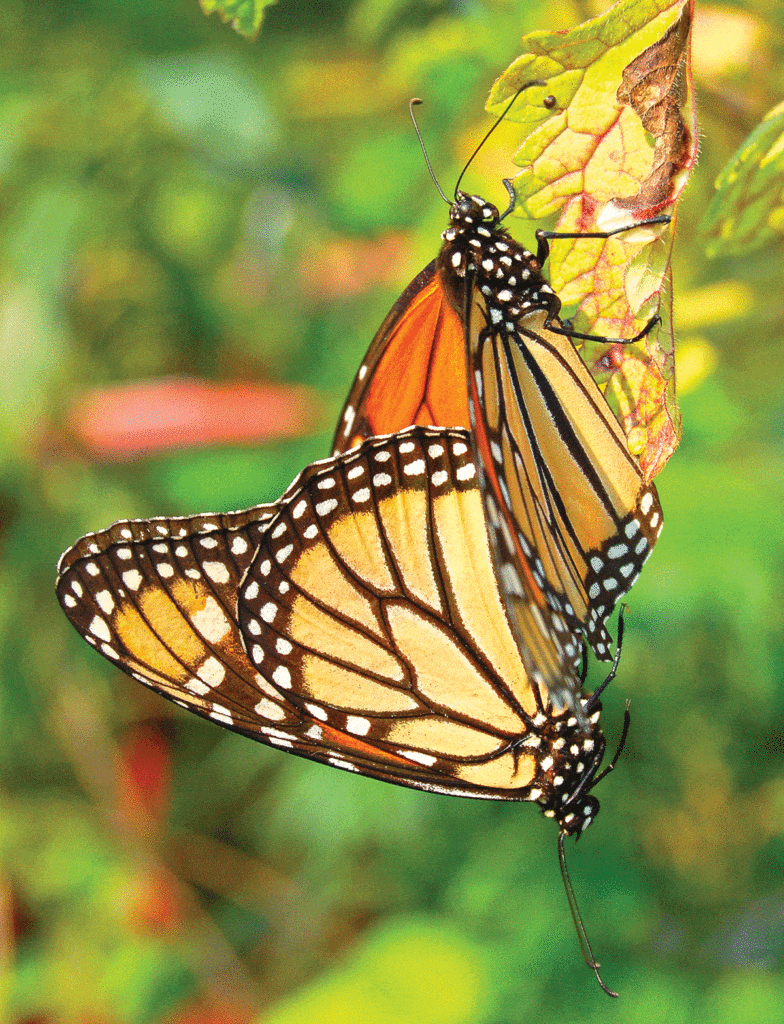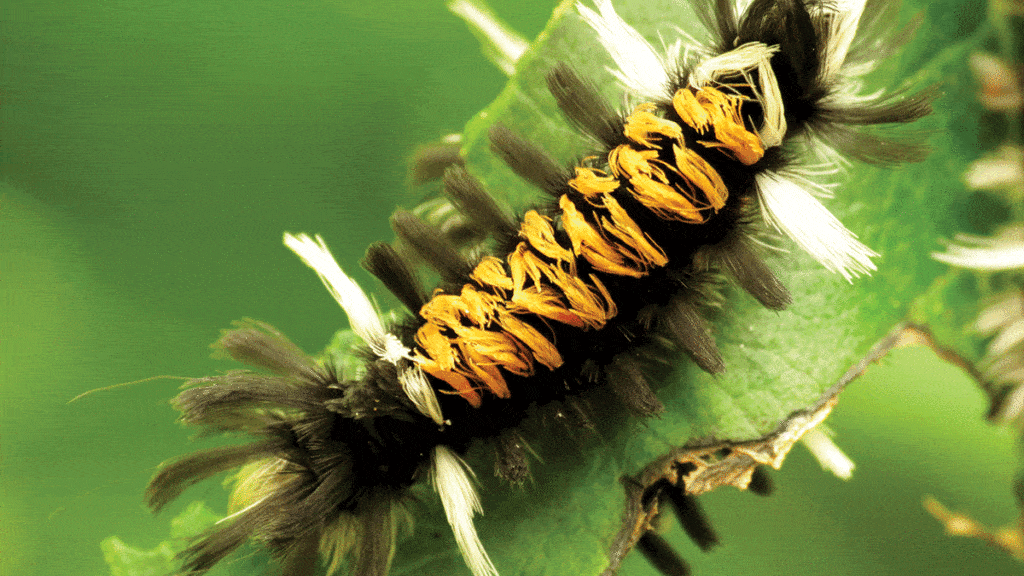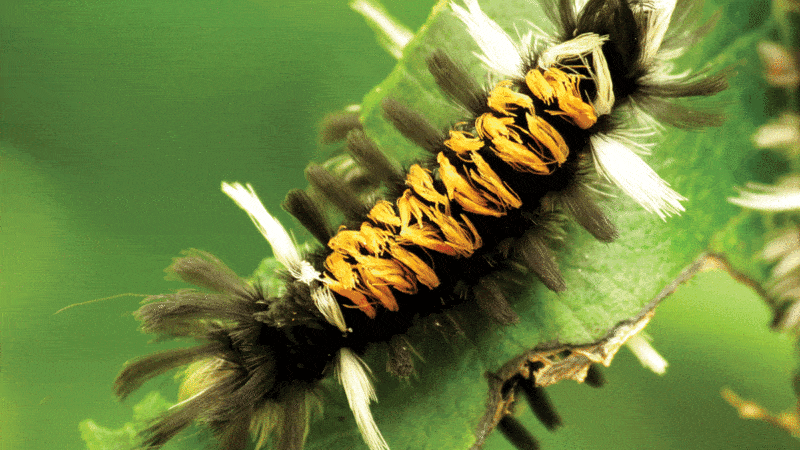How to Help Two Milkweed-Loving Insects
by Dr. Sarah Treanor Bois
Director of Research & Education at the Linda Loring Nature Foundation
A few weeks ago, I wrote about the diversity of milkweed plants that grow on Nantucket. By now, the blossoms have faded, the seed pods are maturing, and the lush leaves continue to photosynthesize in the hot August sun.
Turn over some of those leaves and you may find tiny white eggs or even a small caterpillar or two. It’s time for the monarchs and other milkweed-loving caterpillars to gorge themselves silly on the buffet of milkweed leaves across the island.
Monarch butterflies, and their early stages as caterpillars, are one of the most charismatic pollinators inspiring many a kindergarten classroom and backyard gardener. The monarch butterfly is one of the most recognizable species in North America and, as such, is used as the poster child for protecting our wild spaces. Think of it as an ambassador to a mosaic of grassland plants and animals that all need soil, sun, and time to grow. Since the number of monarchs has been decreasing, the butterflies have been used to demonstrate why broadcast pesticides are harmful, as are habitat loss, habitat fragmentation, and non-native species. Efforts to support monarch populations also help countless other less-charismatic species of insects and plants.

One way to help monarchs? Please don’t take them off of plants. Many butterfly enthusiasts love to collect and raise monarchs in an effort to help their declining populations. While well-intentioned, these captures could actually do more harm than good.
New research from the University of Chicago demonstrated that monarchs raised in captivity may have a more difficult time migrating come fall. Even the monarchs sourced from wild populations have a hard time orienting south – the direction they need to go.
Previous research from the same group (published in 2019) showed that commercially-raised monarchs – the kind people order form the internet – were worse at orienting south than their wild counterparts. These commercially available monarchs were genetically distinct. This new research now shows that any captivity can affect the butterfly’s ability to migrate.
What changes when a wild monarch is raised in captivity? There is some environmental cue that the insect isn’t getting that it needs for successful migration. What that cue is, is still unknown. Researchers ruled out light by raising wild butterflies in a greenhouse with natural light. Other factors are being tested now.
So, what does this mean on Nantucket? Please don’t take the monarchs out of the wild! Even if you’re careful. Even if your kids will love it. Even if you’re a teacher. We want them to succeed and breed so we can see them again next year. Monarchs know how to do monarchs the best.
What can you do to help?
Let the milkweed be and plant more! Maybe you loved the milkweed blossoms at the edges of your yard, but they are starting to look scraggly. Please don’t remove them just yet. They are still a salad bar for our milkweed loving insects! And they need all the leaves they can get. Caterpillars are voracious!
Removing milkweed plants reduces the possibility of it coming back next year. We need the seed pods to mature and open on their own. If you’re inclined to pick milkweed from other places to feed monarchs, collecting “in the wild” also means potentially removing from private property. Most of the conservation land on Nantucket is actually private property that we are all allowed to enjoy. Please “take nothing but pictures” as the saying goes.
What’s so important about the milkweeds for monarchs? When the monarch eggs hatch into larvae, otherwise known as caterpillars, the caterpillars’ main job is to grow, so they spend most of their time eating. They only eat milkweed, which is why this plant is so important – without milkweed there are no monarchs.
The caterpillars eat their fill for about two weeks, and then they spin protective cases around themselves to enter the pupa stage, which is also called a “chrysalis.” About a week or two later, they finish their metamorphosis and emerge as fully formed, black-and-orange, adult monarch butterflies. This is when the nectar feeding begins. At this stage, monarchs need nectar flowers to bulk up for the big migration. As September rolls around, goldenrods and the multitude of fall asters help the monarchs’ search for nectar.
September marks the beginning of fall migration for millions of monarch butterflies. Adult monarchs are partway through their lifecycle, but their reproduction is on hold. These monarchs are different from their parents, grandparents, and even great grandparents. Previous generations completed their life cycle in four weeks. Each of these previous generations migrated north, resulting in four generations over the course of the summer. Butterflies in this last generation are members of the generation that migrates south, often called the monarch “super generation”.
With all this talk about monarchs, let’s not forget about the other milkweed loving beast – the milkweed tussock moth. The hairy caterpillar of the milkweed tussock moth (MTM) looks like an orange, white, and black teddy bear in its late stage of development. Just like monarchs, the MTM relies on milkweed plants for survival to adulthood. It ingests the toxins from the milkweed and stores it in their bodies. Their bright coloration warns predators (like birds) of their toxicity.
These native caterpillars need the milkweed just like the monarchs and they have evolved alongside each other. Please don’t pick them off in favor of monarchs. They all need the milkweed.
As adult moths, the MTM is much less charismatic than the monarch butterflies. Their gray wings and hairy yellow-orange abdomens don’t inspire a conservation movement. They also lack a cool migration story residing in one place their entire lives. On Nantucket, monarchs are more like summer residents while the MTM is an old salt. At the end of the caterpillar development when the MTM caterpillars are fat and happy, the milkweed tussock moths pupate and spend the winter as hairy cocoons. They emerge as adult moths in early summer to mate and lay eggs starting the cycle all over again.

While less exciting than monarchs, efforts to increase milkweed populations and protect monarchs from pesticides also protect this native species.
No matter who you are or where you live, you can help monarchs and milkweedloving species by getting involved today. Start by planting milkweed and nectar plants that are native to your area; whether it’s Nantucket or your home location. Garden organically to minimize your impacts on monarchs, their food plants, and other pollinators. And support organizations that protect native habitat.



